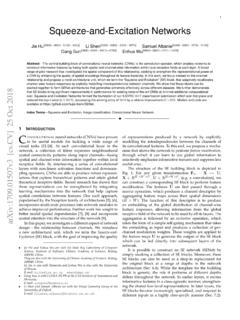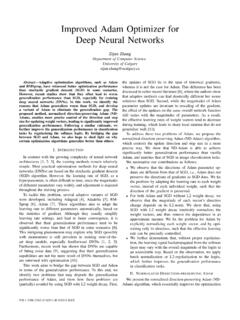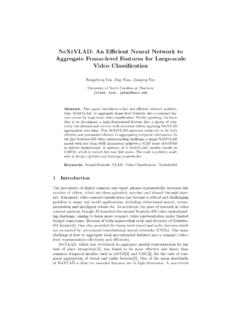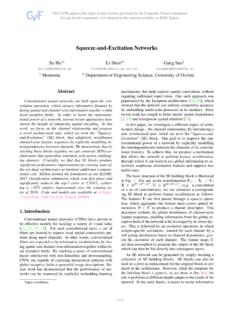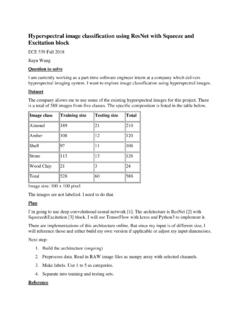Transcription of Squeeze-and-Excitation Networks - ImageNet
1 Squeeze-and-Excitation NetworksJie Hu1, Li Shen2 , Gang Sun11 Momenta 2 University of OxfordConvolutionA convolutional filer is expected to bean informative combination Fusing channel-wiseand spatialinformation Within local receptive fields Exploration on Spatial Enhancement Multi-scale embeddingInception [9]Contextual embeddingInside-outside network [13] Squeeze-and-Excitation (SE) Networks If a network can be enhanced from the aspect of channel relationship? Motivation: Explicitly model channel-interdependencies within modules Feature recalibration Selectively enhance useful features and suppress less useful ones Squeeze-and-Excitation ModuleSqueeze Shrinking feature maps 2through spatial dimensions ( ) Global distribution of channel-wise responsesExcitation Learning 2 2to explicitly model channel-association Gating mechanism to produce channel-wise weightsScale Reweighting the feature maps 2SE-Inception ModuleSE-ResNetModuleInceptionGlobal poolingFC FC 1 1 16 1 1 1 1 ScaleSigmoid 1 1 Residual +Global poolingFCFC 1 1 16 1 1 1 1 ScaleSigmoid 1 1 Inception Residual + Inception ModuleResNetModuleModel and Computational ComplexitySE-ResNet-50 vs.
2 ResNet-50 Parameters: 2%~10% additional parameters Computation cost: <1%additional computation (theoretical) GPU inference time: 10%additional time CPU inference time: <2%additional time Training Momenta ROCS Data augmentation Mirror flip, Random size crop [9], Rotation, Color Jitter Mini-batch data sampling Balance-data strategy [7] Training hyper-parameters 4 or 8 GPU severs (8 NVIDIA Titan X per server) Batch-size: 1024 / 2048 (32 per GPU) Initial learning rate : (decrease each 30 epochs) Synchronous SGD with momentum Experiments on ImageNet -1k dataset Empirical investigations on: Benefits against Deeper Networks Incorporation with modern architectures ILSVRC 2017 Classification TaskBenefits against network DepthBenefits against network DepthIncorporation with Modern Architectures Incorporation with Modern Architectures Comparison with State-of-the-artSENetis aSE-ResNeXt-152 (64 4d)ILSVRC 2017 Classification TaskTeamTop-5 error (%) 2016 [1] K.
3 He, X. Zhang, S. Ren, and J. Sun. Deep residual learning for image recognition. In CVPR, 2015.[2] K. He, X. Zhang, S. Ren, and J. Sun. Delving deep into rectifiers: Surpassing human-level performance on imagenetclassification. In ICCV, 2015.[3] K. He, X. Zhang, S. Ren, and J. Sun. Identity mappings in deep residual Networks . In ECCV, 2016.[4] G. huang, Z. Liu, K. Weinberge, and L. Maaten. Densely connected convolutional Networks . In CVPR, 2017. [5] S. Ioffeand C. Szegedy. Batch normalization: Accelerating deep network training by reducing internalcovariate shift. In ICML, 2015.[6] O. Russakovsky, J. Deng, H. Su, J. Krause, S. Satheesh, S. Ma, Z. Huang, A. Karpathy, A. Khosla, M. Bernstein,A. C. Berg, and L. Fei-Fei. Imagenetlarge scale visual recognition challenge. In IJCV, 2015.[7] L. Shen, Z. Lin, and Q. Huang. Relay backpropagation for effective learning of deep convolutional neural Networks . In ECCV, 2016. [8] C.
4 Szegedy, S. Ioffe, and V. Vanhoucke. Inception-v4, inception-resnetand the impact of residual connections onlearning. In arXivpreprint , 2016.[9] C. Szegedy, W. Liu, Y. Jia, P. Sermanet, S. Reed, D. Anguelov, D. Erhan, V. Vanhoucke, and A. deeper with convolutions. In CVPR, 2015.[10] C. Szegedy, V. Vanhoucke, S. Ioffe, J. Shlens, and Z. Wojna. Rethinking the inception architecture for computervision. In CVPR, 2016.[11] S. Xie, R. Girshick, P. Dollar, Z. Tu, and K. He. Aggregated residual transformations for deep neural Networks . In CVPR, 2016.[12] X. Zhang, Z. Li, C. Chen, and D. Lin. Polynet: A pursuit of structural diversity in very deep Networks . In CVPR, 2017. [13] S. Bell, C. L. Zitnick, K. Bala, and R. Girshick. Inside-Outside Net: Detecting Objects in Context with Skip Pooling and Recurrent Neural Networks . In CVPR, you

